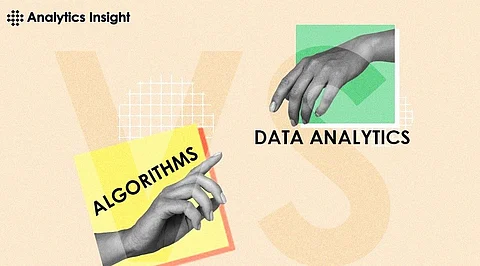Algorithms vs Data Analytics: Concepts and Applications

Unveiling the synergy: Algorithms and data analytics in driving insights and innovation
In the realm of data science, two fundamental concepts often intersect and collaborate to drive insights, innovation, and informed decision-making: algorithms and data analytics. While they are closely related, each serves a distinct purpose and plays a crucial role in extracting value from data across various domains such as healthcare, media, education, and finance.
Algorithms serve as the backbone of computational processes, providing step-by-step instructions for computers to execute specific tasks or solve particular problems efficiently. These instructions encompass a wide range of operations, from basic arithmetic calculations to complex decision-making processes. In essence, algorithms form the building blocks of computational logic, enabling machines to process data and perform actions based on predefined rules and patterns.
On the other hand, data analytics involves the systematic exploration, transformation, and interpretation of data to uncover meaningful insights, patterns, and trends. It encompasses a range of techniques and methodologies aimed at extracting knowledge from data, with the ultimate goal of facilitating data-driven decision-making and problem-solving. Data analytics leverages various tools and approaches to process and analyze data, including statistical analysis, machine learning, data mining, and optimization.
Some of the concepts and applications of algorithms and data analytics are:
One of the prominent applications where algorithms and data analytics converge is in the field of machine learning. Machine learning algorithms empower computers to acquire knowledge from data and enhance their performance autonomously, without the need for explicit programming. These algorithms can be categorized into four main types: supervised learning, unsupervised learning, semi-supervised learning, and reinforcement learning. Machine learning finds diverse applications, including image recognition, natural language processing, recommendation systems, and fraud detection, among others.
Data mining, another key application area, focuses on extracting valuable patterns, trends, and associations from large and complex datasets. Data mining algorithms encompass a variety of techniques such as classification, regression, clustering, association rule mining, anomaly detection, and summarization. These algorithms are widely used in applications such as customer segmentation, market basket analysis, sentiment analysis, and outlier detection, providing valuable insights for decision-making and strategic planning.
Optimization techniques play a vital role in enhancing efficiency and maximizing outcomes across various domains. Optimization algorithms aim to find the best solution or outcome for a given problem while adhering to specified constraints. These algorithms can be classified into deterministic and stochastic approaches and find applications in diverse areas such as scheduling, routing, resource allocation, and portfolio optimization, optimizing processes and resource utilization.
Simulation, another critical application domain, involves creating models to mimic real-world systems or phenomena and experimenting with them to observe behavior and outcomes. Simulation algorithms can be discrete-event or continuous, allowing for the analysis of complex systems and scenarios. Simulation finds applications in risk analysis, forecasting, testing, and training, providing insights into system dynamics and behavior under different conditions.
Conclusion
In conclusion, algorithms and data analytics applications are integral components of data science, working together to extract insights, solve problems, and drive innovation across various domains. While algorithms provide the computational foundation for processing data and performing tasks, data analytics encompasses a broader set of methodologies and techniques for extracting knowledge and insights from data. By leveraging algorithms and data analytics effectively, organizations can harness the power of data to make informed decisions, optimize processes, and unlock new opportunities for growth and innovation.
.png)

